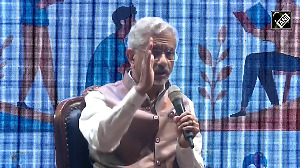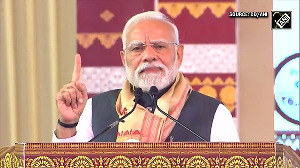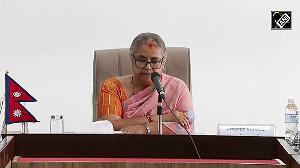Who writes better e-mails in India? Women or men?
-
E-mails written by women show a higher degree of adherence to principles of politeness than those written by men.
-
Men, in their e-mails, used praise and approval of the recipient's actions more than women.
A pioneering study done by the Indian Institute of Management, Ahmedabad on the relationship between gender, politeness and e-mail content has come out with interesting details.
The e-mail survey was conducted by IIM-A Associate Professor in Communications Asha Kaul and academic associate Vaibhavi Kulkarni.
For the purpose of the study, the authors sent e-mails to various organisations in India soliciting samples of work related e-mails.
Additionally, students and colleagues were requested to share task-oriented e-mails. 494 e-mails were received. Of these, 250 were written by men and 244 by women. All names were deleted from the e-mails. The gender, 'male' or 'female', of the sender was written on top of the mails to facilitate coding on the basis of gender.
All mails had either a request (pertaining to work) to be made, job/task to be assigned, or information to be solicited. While all e-mails were task-oriented, they varied in the degree and form of politeness.
Some adhered to explicit expressions of politeness in the interest of securing cooperation, some indicated presence of more than one maxim of politeness, some made use of 'explicit expression of politeness through words' or politeness indicators as 'Please', 'Thank you', some directly violated the politeness maxims.
What are the findings of the survey?
- E-mails written by women showed extensive use of approbation and agreement.
- E-mails written by women showed a higher degree of adherence to principles of politeness than those written by men.
- Tact and approbation were two positive politeness maxims used frequently in e-mails by both men and women. However, it was found that there was high persistence of approbation maxim among males.
- Men, in their e-mails, used praise and approval of the recipient's actions more than women.
- The e-mails written by women showed hesitancy to openly contradict or disagree. The mails were more appeasing and tentative rather than firm and clear.
- An interesting finding from the analysis of the e-mails was the tendency or desire to bond with the recipient through written communication. A variation in this 'bonding' technique was found in the mails written by men and women.
- Men attempted 'bonding' through the use of approbation or approval.
- Women attempted 'bonding' by making 'inane talk'.
- In other words, men played the role of the head in a patriarchic society, praising and motivating, which is typical of the Indian culture, and women indulged in 'relationship building' by inquiring about the well-being of the recipient, family members, etc, before moving on to work related topics.
-
In the e-mails sent by men, while there was adherence to the politeness principle, violations of maxims were also witnessed. Instances of violations were in the nature of 'sarcastic politeness' or 'camouflaged politeness'.
- Maxims of sympathy, modesty and generosity were used in almost equal proportion by both men and women.
An example of sympathy that women and men showed in their e-mails:
Women: 'Now that you mention it, I do remember your name (and IIM) from the programme. Israel (not only Eilat but also Tel Aviv, where I spent a night after the conference) was fabulous -- too bad you missed it.'
Men: 'I am saddened by the devastation that your country and so many others have suffered.'
-
Men and women, while assigning tasks, were both tactful and 'atactful' or 'untactful'. Women, however, were more tactful while assigning tasks and men more 'atactful'. Both men and women made use of explicit expression of politeness through words' like 'requested', 'kindly', 'sincerely', 'please', 'can we', 'may we', 'suggested', 'grateful', etc., at the time of assigning tasks in their 'tactful' mails, but since most of the e-mails written by women were 'tactful' in nature, obviously the use of explicit expressions of politeness through words used by women were also more.
What prompted IIM-A to embark on the study?
Prof Kaul says IIM-A embarked on the study to analyse the level or extent of politeness or type of principles used/abused to solicit cooperation in e-mails by males and females in India.
"The study is an attempt to get an understanding of e-mails written by men and women in India," Prof Kaul told rediff.com. "An analysis of gender written communication patterns in the use of politeness within e-mails in India would lead to a better understanding of how men and women approach task oriented communication," she pointed out.
IIM-A academic associate Vaibhavi Kulkarni said they were interested in the study because with the increasing number of women at workplace, task-oriented interaction between men and women has increased.
"Getting work done requires cooperation from other colleagues, external clients, etc and it becomes important to maintain politeness for the same," she said.
At the same time, Kulkarni pointed out, e-mails are being used frequently to communicate at work and they take a form of 'intellectual written shorthand' and are often informal in nature.
"Hence, we wanted to know whether the same kind of politeness principles are also followed in e-mails. Also, we were interested in how gender can affect the use politeness in e-mails," she told rediff.com.
Prof Kaul says the study raises several issues related to e-mails, gender and its effect on use of cooperation through politeness and politeness maxims in task-oriented e-mails written by men and women.
They include the extent to which emphasis should be laid on intent and explicit expression, significance of use of specific/certain words, universality of principles for writing e-mails, relation between gender patterns in written language and e-mails and role of politeness in defining the quantum of cooperation in e-mails.
The researchers say the study of e-mails in the context of gender and politeness is still a fertile ground for future researchers.
"Considering the comparative novelty of the medium, the options and the possibilities of research and analysis are multiple. Additionally, its intrinsic similarity with face-to-face communication and written communication and extrinsic dissimilarity with the existing media of communication make it a challenging area for research," the e-mail research paper said.




